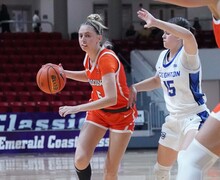Chemistry professor, team wins scientific discovery prize
Mathew Maye has been working with particles billions of times smaller than a single speck of dust. It’s a part of his job as a ‘craftsman’ at the Brookhaven National Laboratory in Upton, N.Y.
But unlike most craftsmen, Maye doesn’t use nails or hammers — not when he can replace those tools with the principles of biology and chemistry.
‘The project allowed us to make structures that had really never been made before,’ Maye said. ‘So we kind of consider ourselves craftsmen of the lab.’
Using synthetic DNA, Maye and a team of three other researchers designed a new way to assemble nanoparticles — the dimensions of which can be measured in a billionth of a meter. The DNA contains complementary bases that pair with one another to attach the nanoparticles together, Maye said.
The group’s findings led them to win a Gordon Battelle Prize for scientific discovery on Feb. 1.
Five prizes are given out in the scientific discovery category to recognize and honor researchers who have made important advances in the field, said Katy Delaney, national media relations manager of Battelle.
‘It’s the ones that had the most impact, ones that signified a real breakthrough achievement,’ she said.
The discovery can be used in many different fields, including biological and medical research, energy research and electronics, Maye said. The team wants to use its discovery to produce a concrete product that can be purchased, such as a device or a computer chip, Maye said.
The Gordon Battelle Prize is an honor Maye, now an assistant professor of chemistry at Syracuse University, appreciates because it was awarded to the team as a whole. The work of all four members — led by Brookhaven lab scientist Oleg Gang and including researchers Dmytro Nykypanchuk and Daniel van der Lelie — was recognized collectively, Maye said.
Maye said he was a part of what he called an ‘interdisciplinary team’ because each member had different backgrounds. Maye was mainly in charge of synthesizing nanoparticles.
The team’s discovery is continuing to get recognition nationwide, starting with the 2008 cover of the science journal Nature.
When Maye first joined the team, he was a Goldhaber Distinguished Fellow, a Brookhaven fellowship given to individuals who show promise in their independent research. The team began working together in 2005.
It was between 2006 and 2008 when the team made significant progress in its discovery.
‘When we were starting work on this, you couldn’t be sure that what we were planning, that it would work and that we would get results,’ said Nykypanchuk, one of the Brookhaven researchers on the team. ‘But the point when you realize that it works, it’s very exciting, and it feels good.’
Without the team’s dedication, the discovery would not have been possible. Sometimes they only got three hours of sleep — if at all — for three to four days in a row, Nykypanchuk said.
And Maye never wasted any time, Nykypanchuk said.
‘He was a nice person on a personal level,’ he said, ‘but you had to keep up with him.’
It was Maye’s hard work and commitment that made it ‘very inspirational to work with him,’ Nykypanchuk said.
But in fall 2008, Maye decided to make the move to SU.
Balancing his responsibilities as an SU professor and as a Brookhaven researcher is difficult, Maye said, but it’s ‘just a part of what we do.’
Although Maye doesn’t spend his every day at the Brookhaven laboratory like he used to, he communicates with his team via e-mail and visits every so often.
The Brookhaven laboratory is overseen by the Department of Energy, Maye said, and it has instruments — some of which ‘take up half a football field’ — that cannot be stored at SU but are necessary for the team’s research.
‘In our field, we need to use the absolute best and the most state-of-the-art machines,’ Maye said.
That means Maye has to return to Brookhaven every few months. And when he does, he brings with him a group of SU students and gives them an opportunity to experiment in the government facility.
Providing these chances for students is part of why he began teaching in the first place.
‘It was a great opportunity to pursue my own independent research and to create opportunities to share my skills with students,’ he said.
These are skills that have been recognized on a national scale.
In 2009, he received the Presidential Early Career Award for Scientists and Engineers, the highest honor awarded by the government to young researchers who show potential for leadership in their independent research.
It led to a trip to the White House in January 2010, a very brief meeting with President Barack Obama and an investment in his research.
And these investments help Maye and the team as they continue to find new discoveries, even six years into their research.
‘We are learning things still that are newer and newer,’ Maye said, ‘so we work hard to make the best materials and do the best work possible.’
Published on February 16, 2011 at 12:00 pm





